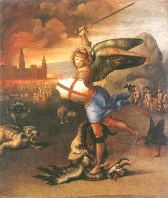Quotes
At Michaelmas time, or a little before, Half an apple goes to the
core; At Christmas time, or a little after,
A crab in the hedge,
And thanks to the rafter.
Traditional English proverb
Modern History
The common story about the boat is it represents the Italian
people coming over to Ellis Island by boat. And supposedly the first
feast was to thank St. Michael the Archangel for bringing them over
here safely."
Legend has it that the original boat was made by a local woman who
prayed to St. Michael for her son, who was sick with typhoid. If he
was cured, she promised to build a boat.
"And she did. He became well. She took a whiskey barrel and took the
pieces of wood and built this boat."
John Barella remembers another of the old traditions -- a
competition involving a greased telephone pole.
"On top of the greased pole there used to be a hundred one-dollar
bills, a buncha pepperoni, Italian salami, a ball of provolone. The
object was to climb the greased pole and if you got to the top, you
were the one that pulled the money down. Now if you got a hundred
one dollar bills, 30, 40 years ago, that was a lotta, lotta money."
History of The Feast of St. Michael's
 Michaelmas
became the fixed date for the feast otherwise associated with Autumn
Equinox or the harvest. As early as 1014, the laws of Ethelred in
England prescribe a three day fast for all Christians before the
feast. Servants weren't allowed to work during these days.
Michaelmas was a time when rents were due, and rents were often paid
in food. The traditional rent for Michaelmas was a goose.
Michaelmas
became the fixed date for the feast otherwise associated with Autumn
Equinox or the harvest. As early as 1014, the laws of Ethelred in
England prescribe a three day fast for all Christians before the
feast. Servants weren't allowed to work during these days.
Michaelmas was a time when rents were due, and rents were often paid
in food. The traditional rent for Michaelmas was a goose.
Eating something rich like goose at this turning point of the year
brings good luck. In Nottingham they say "If you eat roast goose on
Michaelmas day, you will never want money all year." In Norfolk,
they say, "if you don't baste the goose on Michaelmas Day, you will
want money all year." In Yorkshire, they use the condition of the
meat of the goose to predict the weather:
If the goose breast at Michaelmas be dour and dull
We'll have a sour winter, from the start to the full.
Fitzgibbon says the Irish used to stuff the goose with potato to cut
the grease and absorb the flavor. This is like the traditional onion
sauce served with goose in the 18th and 19th centuries and made from
onions cooked in half milk and half water, with a slice of turnip,
then mixed with butter, nutmeg, cream, salt and pepper and mashed.
Apple sauce is the most common topping today.
In Italy, where this is clearly considered a harvest festival, they
say "For St. Michael all the last fruits of the year are honeyed and
ripe."
Cosman says that it is traditional to eat ginger on Michaelmas. She
mentions ginger ale, beer and wine, gingerbread, ginger snaps, fish
baked with ginger and two ginger desserts: charwardon (made with
large succulent wardon pears, cinnamon, nutmeg and ginger) and
ginger caramels with curls of ginger-root shavings on top.
Michaelmas daisy is the name given to flowers of the aster family
which bloom at this time. I've seen it applied mostly to purple
asters but Barolini says she used to pick yellow Michaelmas daisies
on the beaches near Rome. She also made a yellow sponge cake called
"Margherita" (daisy) on that day.
 Michaelmas
became the fixed date for the feast otherwise associated with Autumn
Equinox or the harvest. As early as 1014, the laws of Ethelred in
England prescribe a three day fast for all Christians before the
feast. Servants weren't allowed to work during these days.
Michaelmas was a time when rents were due, and rents were often paid
in food. The traditional rent for Michaelmas was a goose.
Michaelmas
became the fixed date for the feast otherwise associated with Autumn
Equinox or the harvest. As early as 1014, the laws of Ethelred in
England prescribe a three day fast for all Christians before the
feast. Servants weren't allowed to work during these days.
Michaelmas was a time when rents were due, and rents were often paid
in food. The traditional rent for Michaelmas was a goose.